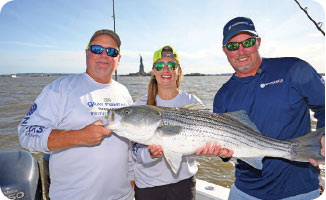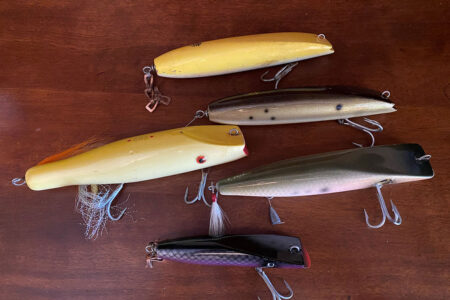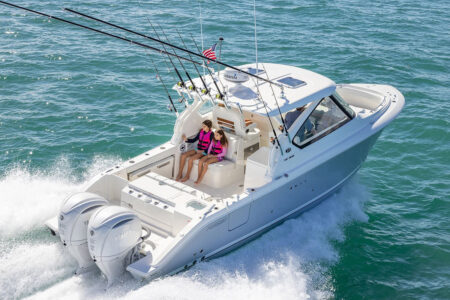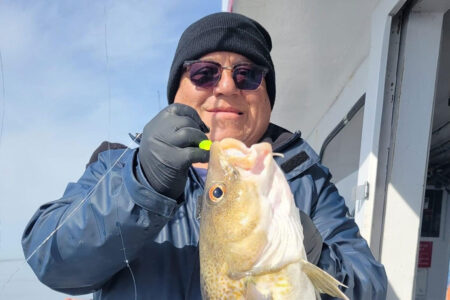Landmark Northeast Striped Bass Study by Gray FishTag Research, Navionics & The Fisherman kicks off.
No one goes fishing simply in hopes of not failing; in fishing, as in life, optimism is what leads to achievement. Every time we leave the dock or step onto the beach with rods rigged and ready to deploy, we envision the new “personal bests” that will follow. On tournament days, that hopefulness is often coupled with extreme anxiety, knowing that only the biggest fish will count, and anything short of total success is complete failure.
Not everyone gets a trophy. Yet in tournament terms, when you come up short one weekend, there’s almost always another contest down the road in another week or two. But when you’ve invested $50,000 in gear, technology, travel expenses and planning just to find a trophy striper – or two – anxiety and optimism play a twisted game with the psyche. Get knocked on your butt here, and it’s pretty hard to climb back up into the fight.
Do or Die

On the morning of May 21, a trophy-hunting team comprised of staff from the nonprofit GrayFishTag Research (GFR), Navionics and The Fisherman stepped aboard Rocket Charters in lower Manhattan with literally tens of thousands of dollars worth of tagging and electronic gear in hopes of successfully deploying a pair of satellite tags in two post-spawn Hudson River striped bass. This first official deployment of the Northeast Striped Bass Study was planned months in advance, taking into account a host of critical elements including May’s full moon, optimum tides, the timing of the upper Hudson spawn, available flights and various work schedules. There could be no next weekend or rain check on this trip; it was do or die trying, a fact not lost on the team or the crew.
After nosing around a couple of his favorite East River locations and picking up a small striper that was sent swimming away with a green GFR spaghetti tag on the port side of its dorsal, Capt. Paul Risi steamed the Rocket west across one of the world’s busiest shipping channels, setting the hook just east of Ellis Island under the watchful eye of Lady Liberty. While smaller GFR tags are provided free to participating charter captains and mates to tag and release fish for tracking by staff scientists and researchers, the pop-up satellite archival tags (PSATs) also carried aboard the Rocket were unique to this unprecedented task of tracking spawning class stripers in their every move over a six-month period. After slipping another handful of spaghetti tags into 20- to 26-inch stripers, registering critical information like size and location on a green GFR tracking slip, the team’s anxiety began to build far greater than tournament style tension.
Sponsored this year by the electronic mapping professionals at Navionics – who stepped up to front the expense of a pair of Wildlife Computer MiniPAT devices – the large-scale movements and behavior of these fish will be collected during deployment and archived in onboard memory which will collect water temperature, pressure, and light data while attached to the fish. Once the tags pop off at a pre-programmed date (in this case on October 21), they’ll ideally float to the surface and relay summaries of the stored data via Argos Satellites back to the folks at Gray. PSATs have previously been used on a limited basis in striped bass research, typically to track a week or two of post-release behavior to assist in gathering mortality estimates. But six months of tracking with the latest, greatest technology on the market today carries a hefty price tag – roughly $5,000 for each tag.
Lady Liberty
For several hours, six sets of eyes gazed at the five conventional outfits spread across the stern in individually numbered rodholders, with bunker chunks and circle hooks deployed with 8 to 10 ounces of weight holding the offerings down near the bottom some 35 feet below the surface. “Number five,” a voice bellowed from the cockpit, as the rod tip bent and line began to slip free from the reel, a good fish finally taking the bait. Paul Michele, National Sales Manager at Navionics Americas grabbed the rod and capably handled a 34-incher into the net. An obvious female (post-spawn) she was placed on a wet towel, head covered with another cold, wet rag to keep her calm and healthy, as scientist Leah Baumwell, the Director at Gray FishTag, carefully inserted the tag.
“This is a medium, Domeier, nylon anchor and we’re actually going to stick the fish about 5 centimeters from the dorsal midline, at an angle, into the muscle or pterygiophores, so that we don’t actually hit any vital organs,” Baumwell described before setting the tag. Named after noted researcher, Dr. Michael L. Domeier, the nylon anchor is attached to 10 centimeters of stainless steel cable to for holding the PSAT in place. “We chose this particular length because we feel that it provides a small amount of drag on the fish so it won’t actually pull out,” said Baumwell, describing how a small charge set for October 21 will ultimately dislodge the tag at the end of the six-month period of study.
And thus, Liberty was released. Each GFR tagged fish is named by angler and crew; charter skippers have named them after their wives and daughters, sometimes sports personalities or musicians. Tracking one’s fish at the GFR website (www.grayfishtagresearch.org) is therefore made more personal; and unlike other tagging operations the data that Baumwell and other GFR researchers track is made available to the public. After burning through a dozen different names on smaller fish, our first larger lady was appropriately named Liberty before being released into New York Harbor en route to six months of tracking.
Late Inning Relief
As the sun continued to fall, nearly touching the statue’s crown in the distance, captains Frank Wagenhoffer and Dave Rooney brought their Fin Chasers 36-foot Contender along off the Rocket’s starboard stern. Capt. Risi had another night charter starting soon, and our team would need a double-shift if we’d hoped to deploy the second PSAT. With 20-knot winds gusting from the NW and the Hudson River emptying itself along in the outgoing tide, Capt. Wags nudged the fenders of his New Jersey charter boat alongside Capt. Risi’s New York craft while Rooney guided the team’s gunnel-over-gunnel transfer for what would amount to 2-1/2 more hours of prime tide. Hope may spring eternal, but preparedness is surely the ultimate act of optimism.

Fresh pieces of bunker were affixed to hooks, as Wags and Rooney feverishly worked the cockpit, rigging heads to circle hooks and deploying chunks to the river bottom in hopes of attracting the recipient of our second PSAT. The class of 2015 showed first, as 20- to 26-inch stripers found their way into the landing net, the names of wives, daughters and even the long missing Teamsters’ boss were laughingly entered onto catch cards as more of the slender, green streamer tags were inserted into the smaller fish. As the 15th striper was tagged and released, Baumwell sat at the ready in the cockpit bench, a $5,000 PSAT cradled in her palm as she and the rest of the team hoped for that one fish.
“The key to what we’re doing is open access, we want to share all the information from all these products with the public,” said Bill Dobbelaer, President of Gray Fishtag Research. Dobbelaer said similar satellite tags have been deployed in other parts of the world on roosterfish, marlin, swordfish, marlin and even barracuda with great success, and he’s optimistic that the Northeast Striped Bass Study can help provide more data for scientists and researchers working with striped bass studies. “We’re hopeful that all this data that we’re collecting can be used someday to make really good decisions on managing all these fish species that we love,” he added.
Sitting, watching, and hoping; it’s just like any other trip. “We’re just waiting for that big striper to come along, put this satellite tag in, and be able to check it out on The Fisherman’s website and see a Navionics app exactly where that fish has gone through its travels,” Michele described on camera while manning the line of baited outfits. “We’re really hoping to learn a lot, and do a lot of good for this research for this fishery.”
What had been most soft takes and taps from finicky fish in the turbid waters of the Hudson was suddenly replaced by a solid hit on one of the spinning outfits. Michele again grabbed the rod and began to fight what he’d hoped was a good striper in the heavy current. Earlier a 24-incher had fought like a monster in the ripping tide, making it hard to gauge whether or not this would be a tag-worthy striper. After five or six minutes of give and take between angler and fish, the broad tail and slab side of a 30-pounder was brought astern and deftly managed into the net by Rooney.
While 40s and 50s were a strong possibility, the 42-inch striper was perfectly suited for the second and final satellite tag. She was out of the water no more than two minutes, and after one quick snapshot with the scientist, angler and net man, the lady striper aptly named Freedom slapped her tail and vanished into the murky waters of the Hudson.
During the winter months as our team discussed the plan via conference call, various names for the two PSAT stripers were tossed around. Hoping to score a good fish in her shadow, Liberty was an obvious choice. Given that the first of what we hope to be many future tagging efforts focused on the New York stock, Hudson quickly became our second favorite. But once that 42-incher disappeared below the surface, after high fives were exchanged in the cockpit, lines reeled in and the anchor hauled aboard, the team looked back at the Statue of Liberty and ahead towards our final disembarking point at North Cove Marina at the base of the Freedom Tower, and a new name was born.
And thus we toasted our stripers, Liberty and Freedom, and this milestone project. It was a mission that took six months of planning and literally “spanned” two interstate charter operations over six hours of fishing to literally set into motion. And so begins another six months of anxious optimism; much like waiting for that tournament fish to swallow the bait.
To see the full video of our tagging trip, go to TheFisherman.com.




